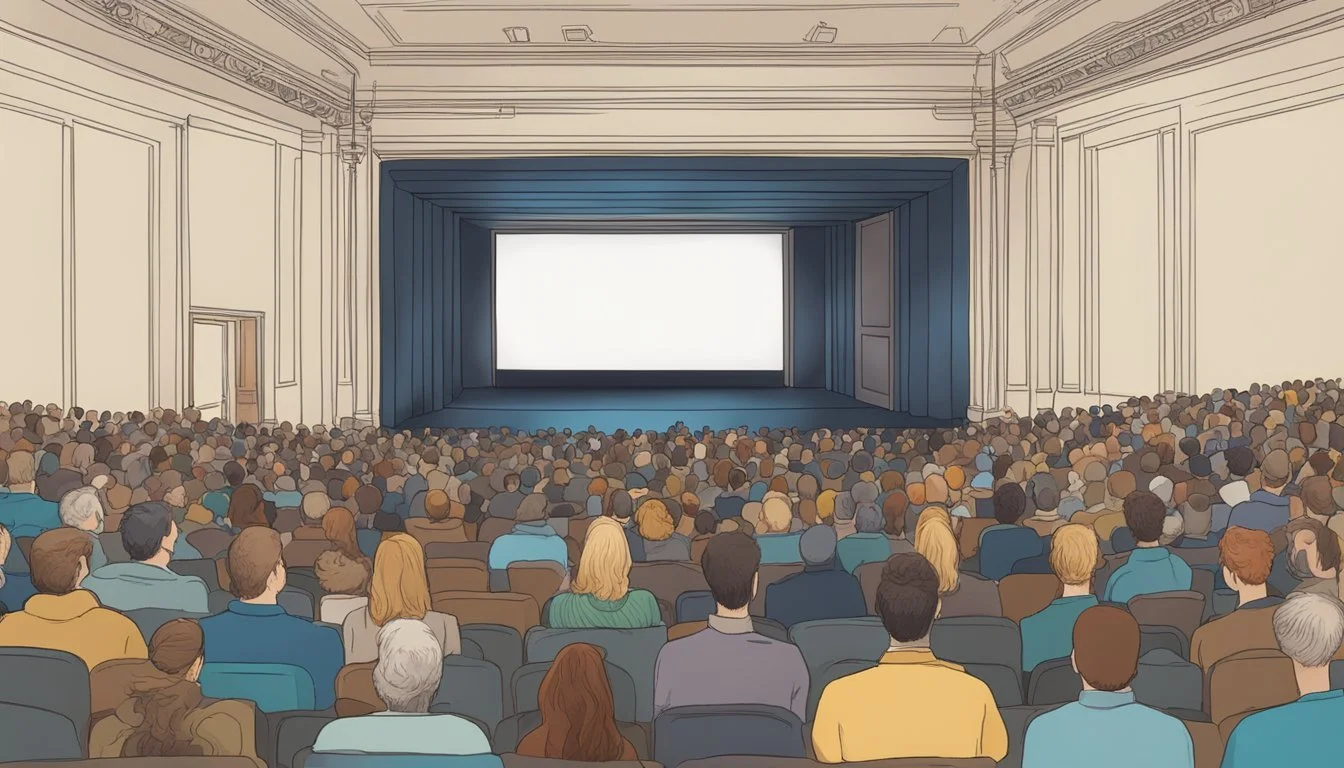Top Documentaries of 1975
Essential Viewing from a Landmark Year in Film
The year 1975 marked a significant period in documentary filmmaking, with several influential works released that captured important events and cultural shifts of the era. These documentaries provided viewers with unique insights into social, political, and artistic developments occurring both in the United States and around the world.
Documentary films from 1975 continue to be celebrated for their groundbreaking approaches to storytelling and their ability to shed light on complex issues of the time. Many of these works employed innovative techniques that pushed the boundaries of the medium, setting new standards for future generations of documentary filmmakers. From intimate character studies to sweeping historical narratives, the documentaries of 1975 offer a fascinating glimpse into a pivotal moment in cinematic and cultural history.
1) Grey Gardens (1975)
Grey Gardens is a groundbreaking documentary directed by Albert and David Maysles. It offers an intimate look into the lives of Edith Bouvier Beale and her daughter, Little Edie, relatives of Jacqueline Kennedy Onassis.
The film captures the eccentric pair living in squalor at their dilapidated East Hampton mansion, Grey Gardens. Once members of high society, the Beales are shown in their isolated world, surrounded by decay and numerous cats.
The documentary employs a direct cinema approach, allowing the subjects to reveal their personalities and relationship dynamics without narrator intervention. This technique provides viewers with an unfiltered glimpse into the Beales' daily lives.
Grey Gardens gained critical acclaim for its raw portrayal of its subjects. It has since become a cult classic, inspiring adaptations in various media forms. The film's influence extends beyond cinema, impacting fashion and popular culture.
The International Documentary Association ranks Grey Gardens as the ninth greatest documentary of all time. Its unique subjects and innovative filmmaking techniques have cemented its place in documentary history.
More information on Grey Gardens
2) Jaws: The Shark is Still Working
"The Shark is Still Working" is a documentary film exploring the impact and legacy of Steven Spielberg's 1975 blockbuster "Jaws." Produced by dedicated fans over a seven-year period, it builds upon Laurent Bouzereau's 1995 documentary.
The film features interviews with cast and crew members from "Jaws," providing behind-the-scenes insights and personal reflections. Roy Scheider, who starred in the original movie, narrates the documentary.
"The Shark is Still Working" examines how "Jaws" revolutionized the film industry and created the concept of the summer blockbuster. It delves into the production challenges and innovative techniques used to bring the story to life.
The documentary also explores the cultural impact of "Jaws," including its influence on public perceptions of sharks and ocean safety. It pays tribute to the enduring popularity of the film and its place in cinema history.
Dedicated to Peter Benchley, the author of the novel on which "Jaws" was based, the documentary offers a comprehensive look at one of the most significant films of the 20th century.
More information on "Jaws" (1975)
3) Hearts and Minds
"Hearts and Minds" (1974) is a groundbreaking documentary that examines the Vietnam War and its impact on both American and Vietnamese societies. Directed by Peter Davis, the film won the Academy Award for Best Documentary Feature in 1975.
The documentary uses a combination of interviews, archival footage, and on-the-ground reporting to present a critical view of U.S. involvement in Vietnam. It features perspectives from soldiers, civilians, and political figures on both sides of the conflict.
Davis's film takes its title from a quote by President Lyndon B. Johnson about winning the support of the Vietnamese people. The documentary explores the cultural and political factors that led to America's involvement in the war.
"Hearts and Minds" is notable for its unflinching portrayal of the war's human cost. It includes graphic footage of civilian casualties and interviews with veterans struggling to come to terms with their experiences.
The film sparked controversy upon its release due to its critical stance on U.S. foreign policy. Despite this, it has since been recognized as an important historical document and influential work of documentary filmmaking.
4) Brother, Can You Spare a Dime? (1975)
Philippe Mora directed this documentary film that offers a unique perspective on the Great Depression era in America. The film skillfully combines newsreel footage and contemporary film clips to paint a vivid picture of the time period.
James Cagney features prominently, portraying an American Everyman character throughout the documentary. The Andrews Sisters also make appearances, adding to the film's nostalgic atmosphere.
The documentary showcases both the bleak realities faced by many Americans during the Depression and the artistic achievements of the era. It provides a balanced view of this challenging time in U.S. history.
At 1 hour and 52 minutes long, the film received a TV-PG rating. It earned a Golden Globe nomination for Best Documentary Film in 1976, highlighting its critical reception.
While the film offers a wealth of archival material, some critics noted that certain elements, like footage of Franklin D. Roosevelt, may be overused. Nonetheless, it remains a significant documentary from 1975.
5) A Poem Is a Naked Person (1974)
A Poem Is a Naked Person is a documentary film directed by Les Blank. It focuses on singer-songwriter Leon Russell during the early 1970s.
Blank spent two years filming Russell at his recording studio in Oklahoma. The documentary captures Russell's music and performances during this period.
Despite being completed in 1974, the film was not officially released until 2015 due to legal issues. For decades, it could only be shown at special screenings with Blank present.
The documentary provides an intimate look at Russell's creative process and the music scene of the time. It features performances by Russell and other musicians.
Critics have praised the film for its free-form style and candid portrayal of its subject. It offers unique insights into a pivotal period in American music history.
6) The Killing of America
The Killing of America is a controversial documentary film released in 1981, not 1975 as the prompt suggests. It examines violence and crime in the United States through a compilation of graphic footage and interviews.
Directed by Sheldon Renan and Leonard Schrader, the film presents a stark portrayal of American society. It features interviews with convicted killers, law enforcement officials, and forensic experts.
The documentary includes scenes of murders, assassinations, and civil unrest. It aims to highlight what the filmmakers saw as a decline in American society during that era.
Due to its graphic content, The Killing of America faced distribution challenges in the United States. It found a wider audience in Japan, where an extended version was released.
The film remains a provocative and divisive work, praised by some for its unflinching look at violence while criticized by others for its sensationalism.
More information on The Killing of America (1981)
7) The Man Who Skied Down Everest (1975)
This Canadian documentary captures the daring feat of Japanese alpinist Yuichiro Miura as he attempts to ski down Mount Everest. Directed by Bruce Nyznik and produced by F.R. "Budge" Crawley, the film won the Academy Award for Best Documentary Feature.
The documentary follows Miura's ambitious expedition, which involved 850 people and 27 tons of equipment. It showcases the treacherous conditions and challenges faced by the team as they ascend the world's tallest mountain.
The climax of the film features Miura's breathtaking descent, during which he skied 2,000 meters in just over two minutes. The footage captures his 400-meter fall down the steep Lhotse face, adding to the intensity of the viewing experience.
Beyond the skiing spectacle, the film explores themes of human determination and the pursuit of seemingly impossible goals. It offers stunning visuals of the Himalayan landscape and provides insight into the physical and mental preparation required for such an audacious endeavor.
8) Dog Star Man
Dog Star Man (1961-1964) is an experimental film series by avant-garde filmmaker Stan Brakhage. The project consists of a prelude and four parts, released over several years.
The films follow a bearded woodsman and his dog as they climb a snowy mountain to chop down a tree. Brakhage incorporates mystical visions and recurring imagery throughout the series.
Dog Star Man is notable for its non-narrative structure and abstract visual techniques. Brakhage used methods like scratching and painting directly on the film stock to create unique effects.
The series is considered a landmark of experimental cinema. In 1992, it was added to the National Film Registry by the Library of Congress for its cultural significance.
While not a traditional documentary, Dog Star Man's innovative approach influenced future filmmakers in both experimental and documentary genres.
More information on Dog Star Man
9) Harlan County, USA (1976)
Barbara Kopple's groundbreaking documentary chronicles the intense 1973 coal miners' strike in Harlan County, Kentucky. The film captures the raw emotions and struggles of 180 miners and their families as they fight against the Duke Power Company's Eastover Coal Company.
Kopple's intimate approach brings viewers into the heart of the conflict. She showcases the dangerous working conditions, low wages, and determination of the miners to secure better lives for themselves and future generations.
The documentary doesn't shy away from the violence that erupts during the 13-month strike. It depicts confrontations between strikers and company "gun thugs," as well as the tragic death of a young miner.
Harlan County, USA also highlights the crucial role of women in the strike. Wives and mothers stand alongside their men, facing down threats and organizing to keep the movement alive.
The film went on to win the Academy Award for Best Documentary Feature. It remains a powerful portrait of labor activism and the human cost of industrial disputes.
10) Always for Pleasure (1978)
"Always for Pleasure" is a vibrant documentary directed by Les Blank that captures the spirit of New Orleans. The film showcases the city's rich cultural traditions and festive atmosphere.
Blank's camera focuses on various aspects of New Orleans life, including Mardi Gras celebrations, second-line parades, and jazz funerals. The documentary also highlights the city's culinary scene, featuring scenes of locals preparing and enjoying red beans and rice and crawfish boils.
Music plays a central role in the film. Viewers are treated to performances by local musicians and the rhythmic sounds of street parades. The film also features footage of Mardi Gras Indians, showcasing their elaborate costumes and traditions.
"Always for Pleasure" offers an intimate look at New Orleans culture, presenting it through the eyes of its residents. Blank's observational style allows the city's unique character to shine through, creating a lively and authentic portrait.
More information on Always for Pleasure
Historical Context
1975 marked a pivotal year in global affairs and cultural shifts, setting the stage for influential documentary filmmaking.
Significant Events of 1975
The Vietnam War ended with the fall of Saigon in April. This event had profound impacts on international relations and American society. The Watergate scandal continued to reverberate through U.S. politics, shaping public trust in government institutions.
In entertainment, the release of "Jaws" revolutionized the film industry, ushering in the era of summer blockbusters. This shift affected documentary funding and distribution.
The global economy faced challenges with high inflation and rising unemployment in many Western countries. These economic pressures influenced societal issues that documentarians sought to explore.
Societal Trends Influencing Documentary Themes
Environmental awareness grew, spurred by events like the first UN Environment Conference. This led to increased interest in nature and conservation documentaries.
The women's rights movement gained momentum, inspiring films about gender equality and female experiences. Civil rights issues remained prominent, providing subject matter for socially conscious filmmakers.
Technological advancements, including the introduction of Sony's Betamax, began changing how people consumed media. This shift created new opportunities for documentary distribution and audience engagement.
Cultural movements like disco and punk rock emerged, reflecting changing social attitudes. These trends offered rich material for music documentaries and examinations of youth culture.
Prominent Documentary Filmmakers
1975 saw influential directors pushing the boundaries of documentary filmmaking with innovative techniques and impactful storytelling. These filmmakers shaped the genre and left a lasting legacy on cinema.
Key Directors and Their Impact
Kaneto Shindô emerged as a significant figure in 1975 with his documentary on Kenji Mizoguchi. The 132-minute film explored Mizoguchi's life and work, highlighting classics like "The Life of Oharu" and "Ugetsu." Shindô's approach provided deep insights into Mizoguchi's artistry and influence.
Albert and David Maysles continued their observational style with "Grey Gardens." The film offered an intimate look at the eccentric lives of Edith Bouvier Beale and her daughter. Its raw portrayal of the subjects garnered critical acclaim and influenced future documentarians.
Frederick Wiseman released "Welfare," maintaining his signature fly-on-the-wall technique. The film examined the complex interactions within a New York welfare center, showcasing Wiseman's skill in capturing institutional dynamics.
Innovative Filmmaking Techniques
Directors in 1975 employed groundbreaking methods to enhance storytelling. Cinéma vérité techniques gained prominence, with handheld cameras and minimal crew intrusion creating an authentic feel. This approach allowed filmmakers to capture spontaneous moments and raw emotions.
Archival footage integration became more sophisticated. Directors skillfully wove historical clips with contemporary interviews, providing context and depth to their narratives. This technique enriched the visual experience and added layers of meaning to documentaries.
Experimental editing styles emerged, challenging traditional linear narratives. Some filmmakers used non-chronological sequences to create thematic connections, while others employed split-screen effects to juxtapose different perspectives.







